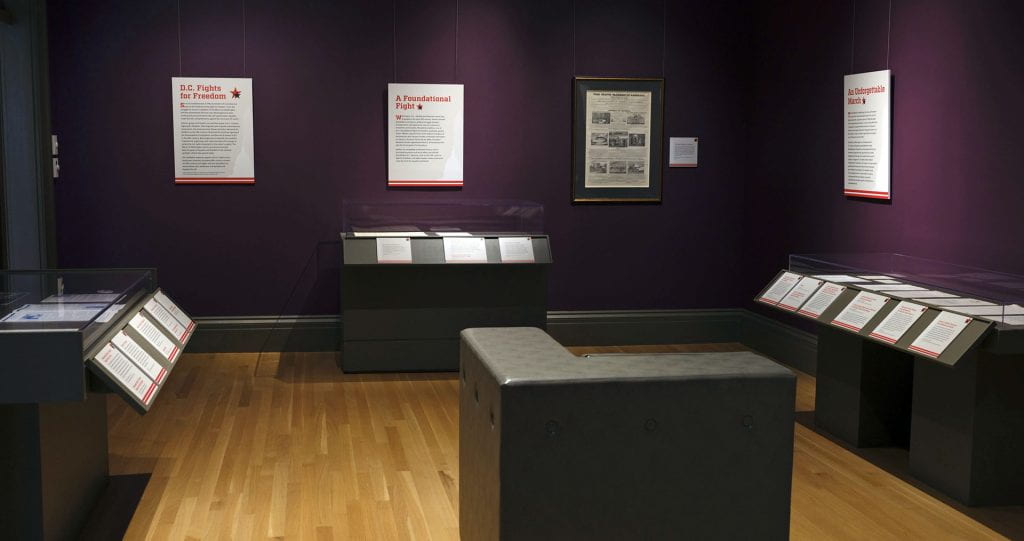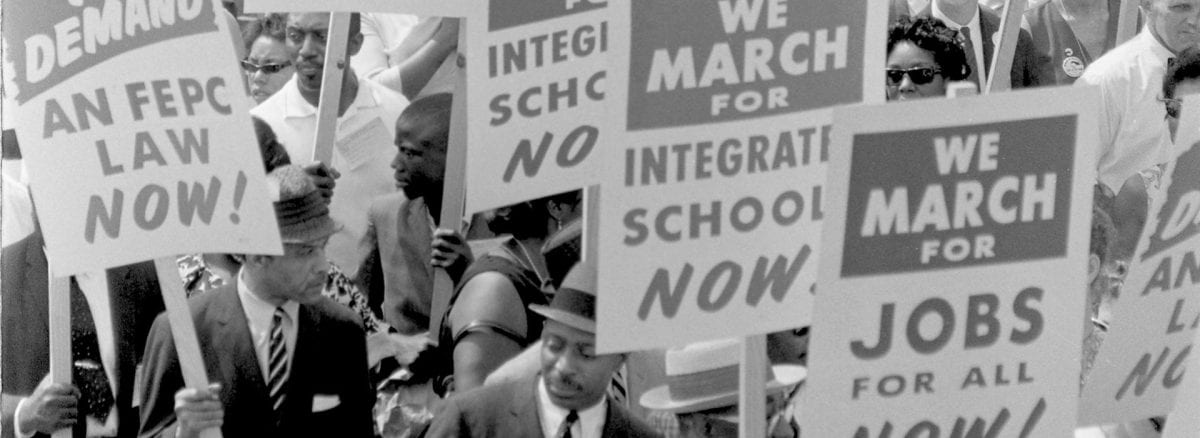By Arooj Fatima, B.S. ‘25, Public Health
Margaret Pizzi, B.A. ‘26, Interaction Design and Art History
Konyae Bostic, B.A. ‘26, Graphic Design
In the nation’s capital, where history is made and ideals are challenged, locals have relentlessly pursued freedom, representation and equality for centuries. The George Washington University Museum and The Textile Museum presents D.C. Fights for Freedom, an exploration of pivotal moments and influential figures in the ongoing struggle for equal rights in the District. The exhibition highlights stories of resilience, activism, and progress, as well as the planning and preparation behind iconic demonstrations. Organized by the Albert H. Small Center for National Capital Area Studies with generous support from the Albert and Shirley Small Family Foundation, D.C. Fights for Freedom includes objects from the museum collection and GW’s Special Collections Resource Center.
The exhibition depicts D.C.’s rich civil rights history from anti-slavery campaigns to the March on Washington for Jobs and Freedom. Objects on display include an 1836 broadside produced by the American Anti-Slavery Society, along with other 19th-century documents that articulate contradictions between founding ideals and slavery in Washington. “An Unforgettable March” highlights Washingtonians’ grassroots organization leading up to Dr. Martin Luther King, Jr.’s “I Have a Dream” speech, and visitors can see an advance copy of King’s remarks. Anniversary marches commemorating that historic moment are also represented through official programs, news releases, and newspaper articles. These objects serve as a reminder of the city’s pivotal role in the nationwide fight for freedom and equality.

Both individuals and groups have made a difference in D.C. The exhibition showcases Walter Fauntroy, an important figure in the District’s history, who transitioned from grassroots organizer to political office holder. On display is a letter from Althenia M. Smith to Fauntroy expressing D.C. residents’ appreciation for his work transforming demonstrators’ energy into legislative action. The exhibition also delves into the intersectionality of the struggle for freedom. The Gertrude Stein Democratic Club’s support of Marion Barry, as well as LGBTQ+ staffers in the mayor’s office, linked gender equality and inclusivity to the fight for civil rights.
Visit the exhibition Tuesday through Saturday, 10 a.m. to 5 p.m., until July 20, 2024.
This post was written by students in Professor Jessica McCaughey’s COMM 3190 class at the George Washington University.
About the Authors
Arooj Fatima is an undergraduate studying public health at GW. She grew up just outside D.C, inspiring her interest in health advocacy, legislation, and how the role of history plays a major role in public health, especially for minorities, who still struggle in many aspects of local and national healthcare in the United States.
Margaret Pizzi is an undergraduate studying interaction design and art history at GW. She has a keen interest in the history of cultures mixed with the contemporary appeal of graphic design and user experience. She serves as co-president of the Visiting Artist and Scholars Committee and vice president of the National Student Speech Language Hearing Association. Both roles center activism and student support on campus, connecting professionals with the GW community.
Konyae Bostic is an undergraduate studying graphic design at GW. He was born and raised in Brooklyn, New York, and is interested in poster design, illustration, and tattoo art. He is a member of the Black Men’s Initiative (BMI), an organization that brings Black men together on campus to hone both professional and personal skills.
Header image: Demonstrators in the 1963 March on Washington for Jobs and Freedom. Photograph by Marion S. Trikosko. Library of Congress, Prints and Photographs Division.
